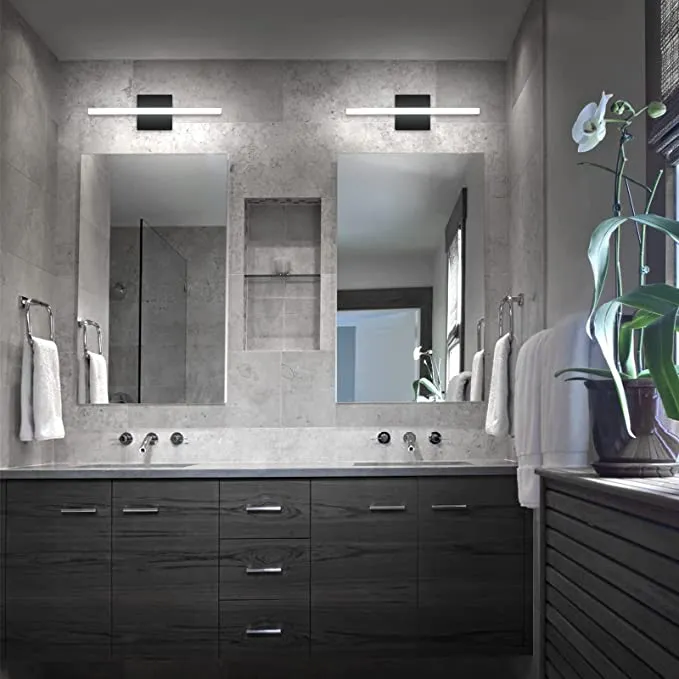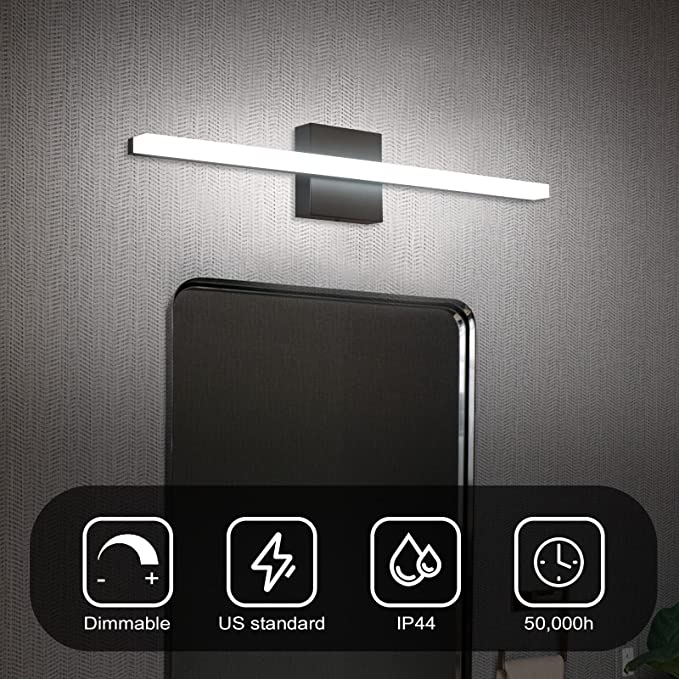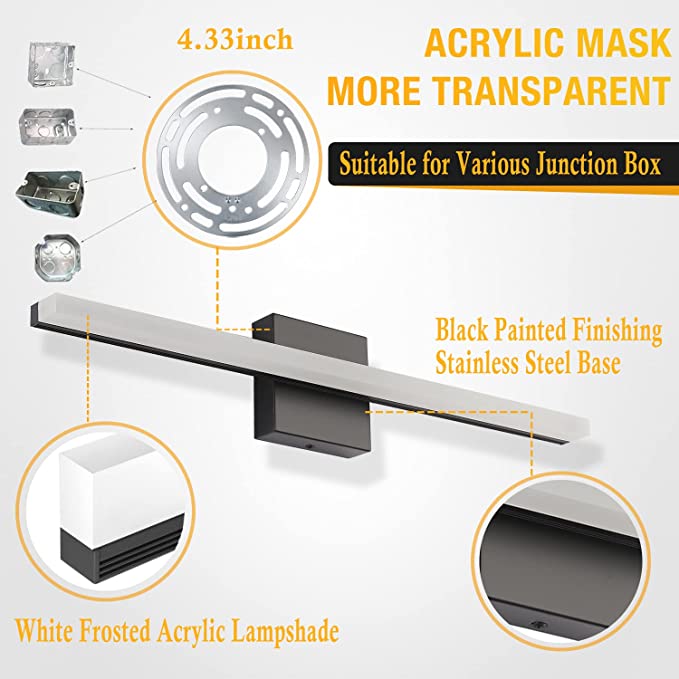LED Vanity Light Fixtures: What Parameters Matter for Eye Protection?
The vanity table is no longer just a space for women to apply makeup; it's also an important place where lighting and aesthetics are combined in daily life. With the popularization of LED technology, LED vanity light fixtures, due to their energy-saving, high brightness, and long lifespan, are gradually becoming essential lighting tools in homes.
The market offers a wide variety of LED vanity light fixtures with complex parameters, making it crucial for consumers to choose a truly eye-friendly option.
This article will provide an in-depth analysis of the core parameters of LED vanity light fixtures from a professional perspective, helping consumers make scientific and rational judgments when purchasing.

LED Vanity Light Fixtures: What is the Significance of Eye Protection?
Compared to traditional incandescent and energy-saving lamps, LED vanity light fixtures have significant advantages in eye protection. First, LED light sources emit light uniformly without frequent flickering, effectively reducing eye fatigue. Second, the color temperature of LED light is adjustable, providing a lighting environment closer to natural light to different makeup needs, thus avoiding color distortion or excessive eye strain.
Furthermore, the low-heat emission characteristics of LED vanity light fixtures prevent eye and skin damage from high temperatures during prolonged use.
However, the "LED" label alone does not guarantee eye protection. Truly eye-friendly LED vanity light fixtures require attention to several professional parameters, including brightness, color temperature, color rendering index, and light source stability.
LED Vanity Light Fixtures: What Parameters are Important for Eye Protection?
Key Eye-Friendly Parameters for LED Vanity Light Fixtures:
1. Luminous Flux (Brightness)
2. Color Temperature (Cool or Warm)
3. Color Rendering Index (CRI or Ra value)
4. Blue Light Hazard and Wavelength Control
5. Flicker-Free Design
6. Beam Uniformity and Anti-Glare Design
7. Power and Energy Efficiency
8. Adjustable Light Modes and Memory Function
9. Light Decay and Lifespan

1). Luminous Flux (Brightness)
Luminous flux, usually expressed in lumens (lm), is an important indicator of a light source's luminous efficiency and brightness. For vanity table use, excessively low brightness can obscure makeup details and increase eye strain; while excessively high brightness can cause glare and eye irritation.
Generally, the recommended luminous flux range for LED vanity light fixtures is 400-800 lumens, adjustable based on the distance between the lamp and the face, makeup needs, and personal preference.
When choosing LED vanity light fixtures, prioritize products with adjustable brightness. This not only facilitates use in different scenarios but also helps protect eye health. Adjustable brightness is usually achieved through stepless dimming (0~100%) or multi-level dimming, with stepless dimming providing a more natural and smooth eye-friendly experience.
2). Color Temperature (Cool or Warm)
Color temperature is measured in Kelvin (K) and reflects the color characteristics of the light source. Excessively high (blue-toned) or excessively low (yellow-toned) color temperatures can cause varying degrees of eye irritation. Eye-friendly LED vanity light fixtures should have an adjustable range of 3000K~6500K, specifically:
• 3000K~4000K: Warm light, soft and suitable for daily makeup and evening use, helping to relieve eye fatigue.
• 4000K~5000K: Neutral white light, closest to natural light, suitable for detailed makeup application, accurately reflecting skin tone.
• 5000K~6500K: This range has a cooler light tone, producing bright and focused light suitable for daytime or low-light environments. However, prolonged use may increase visual strain.
When choosing LED vanity light fixtures, it is recommended to prioritize products with adjustable color temperature for flexible adjustment based on different lighting needs and usage scenarios.
3). Color Rendering Index (CRI or Ra value)
The Color Rendering Index (CRI) indicates a light source's ability to accurately reproduce the colors of objects. The higher the value, the more accurate the color rendering. For eye-care and makeup applications, a CRI of at least 80 is recommended, while professional-grade LED vanity light fixtures typically have a CRI of 90 or higher. A high CRI not only makes makeup colors more realistic but also reduces eye strain from color discrimination.
It's important to note that some low-priced LED vanity light fixtures claim high brightness but have a low CRI. While these lights may appear bright, they are prone to color distortion and visual misleading, thus increasing eye strain.
4). Blue Light Hazards and Wavelength Control
Blue light (400-500nm) is the portion of the light spectrum that can potentially damage the retina. Prolonged exposure to high-intensity blue light can lead to dry eyes, fatigue, and may even accelerate retinal degeneration. Eye-protective LED vanity light fixtures should feature blue light protection designs, such as blue light filter coatings or optimized spectral distribution, to keep the proportion of blue light within a safe range.
When purchasing, look for labels such as "low blue light" or "eye protection certification" in the product description. These types of LED vanity light fixtures minimize potential eye damage while maintaining brightness and color rendering.
5). Flicker-Free Design
Flicker is a significant factor affecting eye protection. Low-quality LED lights often have unstable power supplies, producing high-frequency flicker. This invisible flicker can cause eye fatigue, headaches, and even impaired vision.
Eye-protective LED vanity light fixtures should employ constant current drive technology to ensure stable output light and eliminate the risk of flicker. When purchasing, you can use a mobile phone to take a high-speed photo of the light or use professional testing instruments to observe the flicker situation, ensuring that the LED vanity light fixtures you choose are truly stable and eye-friendly.

6). Beam Uniformity and Anti-Glare Design
Beam uniformity refers to whether the brightness distribution of the light is even within the illuminated area. Eye-friendly LED vanity light fixtures should avoid areas with excessively high or low brightness. Some LED vanity light fixtures are equipped with frosted lampshades, diffusers, or light guides, which can effectively even out the light, reduce direct glare, and be more eye-friendly.
In addition, anti-glare design is also reflected in the lamp head angle and lampshade material. Rotatable and adjustable lamp bodies allow users to adjust the light direction according to their makeup posture, preventing light from shining directly into the eyes.
7). Power and Energy Efficiency
Power is not a direct indicator of eye protection, but it is related to luminous flux. LED vanity light fixtures with too low power may not be bright enough, causing eye strain; those with too high power will produce unnecessary energy consumption and light pollution. Typically, 5-12 watts of power in LED vanity light fixtures is sufficient for home use and eye protection needs.
It's worth noting that LED lights are far more efficient than traditional light sources. For the same brightness, LED lights consume less power, generate less heat, and are gentler on the eyes and skin.
8). Adjustable Lighting Modes and Memory Function
Eye-friendly LED vanity light fixtures usually offer multiple lighting modes or stepless dimming and color temperature memory functions. Users can choose the appropriate mode based on the time of day, makeup needs, and ambient light. The memory function is particularly important for eye-friendly use because it automatically retains the previous brightness and color temperature settings, avoiding tedious adjustments every time the lights are turned on and reducing the strain on the eyes from sudden brightness changes.
9). Light Decay and Lifespan
Light decay refers to the decrease in brightness of LEDs after a period of use. High-quality eye-friendly LED vanity light fixtures should have low light decay characteristics, typically with a lifespan of 30,000 to 50,000 hours. Fixtures with excessively rapid light decay not only experience reduced brightness but may also exhibit color temperature shifts, affecting makeup application accuracy and increasing eye strain.

Practical Recommendations for Choosing LED Vanity Light Fixtures
Based on the parameters above, consumers should follow these principles when choosing LED vanity light fixtures:
• Prioritize LED vanity light fixtures with adjustable brightness and color temperature to ensure eye-friendly use in different scenarios.
• Check the Color Rendering Index (CRI). It is recommended to choose products with a CRI ≥ 90 to accurately reproduce facial colors.
• Pay attention to blue light protection and flicker-free design to ensure that prolonged use will not cause eye damage.
• Choose fixtures with uniform light distribution and anti-glare functions, such as light guide plates, frosted lampshades, and adjustable lamp heads.
• Ensure that power and luminous flux are matched to ensure sufficient brightness without excessive eye strain.
• Consider light memory function and multiple modes for convenient long-term use and eye-friendly experience.
• Verify light decay and lifespan data, and choose high-quality LED chips and constant current drivers to ensure long-term stable eye protection.
What technology and equipment are used in Huari’s production lines?
Our factory employs advanced SMT machines, automatic assembly lines, and aging test systems. Each process — from PCB soldering to driver installation and final assembly — is monitored digitally for accuracy.
We use high-efficiency LED chips and durable housing materials to ensure long-lasting performance. With continuous equipment upgrades, our monthly production exceeds one million units without sacrificing precision.
